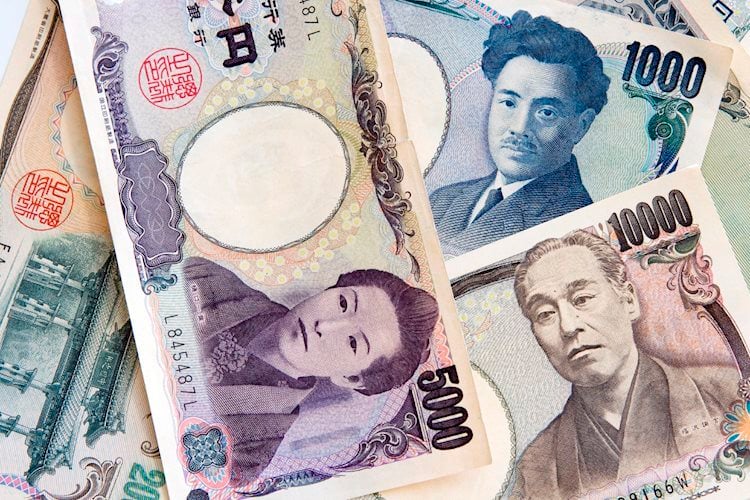- The Japanese Yen dropped to a two-month low against the USD amid the BoJ rate-hike uncertainty.
- Some repositioning trade ahead of the US CPI report prompts profit-taking around the USD/JPY pair.
- Rising bets for a 25 bps Fed rate cut move in November to limit losses for the USD and spot prices.
The Japanese Yen (JPY) recovers a bit against its American counterpart, from the lowest level since early August touched earlier this Thursday, dragging the USD/JPY pair to the 149.00 mark during the European session. The official data released today showed that the Producer Price Index (PPI) in Japan remained unchanged in September and the yearly rate rose more than anticipated during the reported month. This, in turn, is seen as offering some support to the JPY.
The US Dollar (USD), on the other hand, consolidates its recent strong gains to an eight-week top high as traders opt to wait for the release of the latest US consumer inflation figures. This, in turn, prompts traders to lighten their bullish bets around the USD/JPY pair. That said, the uncertainty surrounding the Bank of Japan’s (BoJ) rate-hike plans, along with the risk-on mood, might cap the JPY and limit losses for the currency pair ahead of Japan’s snap election on October 27.
Daily Digest Market Movers: Japanese Yen bulls seem non committed ahead of US CPI report
- Data published on Tuesday showed that Japan’s real wages fell in August after two months of gains and a decline in household spending, raising doubts about the strength of private consumption and a sustained economic recovery.
- This comes on top of blunt comments on monetary policy by Japan’s Prime Minister Shigeru Ishiba and fuels uncertainty over the Bank of Japan’s rate hike plans, which weighed on the Japanese Yen and pushed the USD/JPY pair higher.
- A BoJ report showed on Thursday that the Producer Price Index (PPI) in Japan remained unchanged in September against a 0.3% decline anticipated, while the yearly rate unexpectedly inched up from 2.6% in August to 2.8%.
- In a quarterly survey published this Thursday, the Japanese central bank said that 85.6% of Japanese households expect prices to rise a year from now, compared with 87.5% in the previous survey, offering some support to the Japanese Yen.
- The US Dollar climbs to its highest level since August 16 on the back of Wednesday’s hawkish FOMC minutes, which showed some policymakers indicated that they would have preferred only a 25 bps rate reduction amid still elevated inflation.
- Furthermore, there was a broader agreement that the outsized rate cut would not lock the Federal Reserve into any specific pace for future interest rate cuts and should not be seen as a sign of a more negative economic outlook.
- Dallas Fed President Lorie Logan argued on Wednesday that she favored smaller reductions going forward as there were still real upside risks to inflation and pointed to meaningful uncertainties surrounding the economic outlook.
- Separately, Boston Fed President Susan Collins stressed that policy is not on a pre-set path and will remain carefully data-dependent and added that it will be important to preserve the currently healthy labor market conditions.
- Furthermore, San Francisco Fed President Mary Daly said that the size of the September rate cut does not say anything about the size of the next cuts and that one or two more rate cuts this year are likely if the economy evolves as she expects.
- According to the CME Group’s FedWatch Tool, market participants are now pricing in a greater chance that the Fed will lower borrowing costs by 25 bps in November and over a 20% probability that it will keep interest rates on hold.
- The yield on the rate-sensitive two-year US government bond rose to its highest yield since August 19, while the benchmark 10-year Treasury yield climbed for the sixth straight day on Wednesday, to its highest level since July 31.
- Investors now await the US Consumer Price Index (CPI), due later today, which, along with the US Producer Price Index on Friday, might influence market expectations about the Fed’s rate-cut path and drive the USD/JPY pair.
Technical Outlook: USD/JPY is likely to attract dip-buyers near 148.70-148.65 horizontal support
From a technical perspective, the overnight sustained close above the 38.2% Fibonacci retracement level of the July-September downfall and the 149.00 mark could be seen as a fresh trigger for bullish traders. Moreover, oscillators on the daily chart have been gaining positive traction and are away from being in the overbought territory, suggesting that the path of least resistance for the USD/JPY pair is to the upside. Hence, a further appreciation towards the 150.00 psychological mark en route to the 50% retracement level, around the 150.75-150.80 region, looks like a distinct possibility.
On the flip side, any meaningful slide below the 149.00 mark now seems to attract some buyers near the 148.70-148.65 region. This, in turn, should help limit the downside for the USD/JPY pair near the 148.00 round figure. The latter should act as a key pivotal point, which if broken might prompt some technical selling and drag spot prices to the 147.35 intermediate support en route to the 147.00 mark and the 146.50 area.
Economic Indicator
Consumer Price Index (YoY)
Inflationary or deflationary tendencies are measured by periodically summing the prices of a basket of representative goods and services and presenting the data as The Consumer Price Index (CPI). CPI data is compiled on a monthly basis and released by the US Department of Labor Statistics. The YoY reading compares the prices of goods in the reference month to the same month a year earlier.The CPI is a key indicator to measure inflation and changes in purchasing trends. Generally speaking, a high reading is seen as bullish for the US Dollar (USD), while a low reading is seen as bearish.
